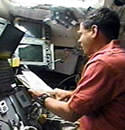
Image credit: NASA
The crew of the space shuttle Columbia have been busy over the last few days as they’ve been completing a series of scientific experiments. Once series of experiments, held in a specially built module, is designed to help scientists understand soot formation, oxidation and radiative properties of flames. There were also a group of biomedical experiments to test the human body’s response to weightlessness.
Columbia’s astronauts studied combustion properties and the response of their own bodies in weightlessness and the behavior of soot in space one-quarter of the way through their marathon scientific research mission.
Red Team members Commander Rick Husband, Mission Specialists Kalpana Chawla and Laurel Clark and Israeli Payload Specialist Ilan Ramon completed the first data collection sessions with the Combustion Module in the Spacehab research module housed in Columbia’s cargo bay. One of three experiments housed in the Combustion Module — the study of Laminar Soot Processes (LSP) — is designed to gain a better understanding of soot formation, oxidation and radiative properties within flames.
Additional data was gleaned from the Mechanics of Granular Materials experiment (MGM) in the Spacehab module, which is providing information on the behavior of saturated sand when exposed to confining pressures in microgravity. The experiment could provide engineers with valuable data for strengthening buildings against earthquakes.
Work was also accomplished with a series of biomedical experiments studying the human body’s response to weightlessness — particularly dealing with protein manufacturing in the absence of a gravity environment, bone and calcium production, the formation of chemicals associated with renal stones and how saliva and urine change in space relative to any exposure to viruses.
Experiments continued with the MEIDEX cameras in the cargo bay observing dust storms in the Mediterranean region and with the SOLSE experiment, geared to studying the amount of ozone in the Earth’s atmosphere by using a special imaging spectrometer in the payload bay to look across the limb of the Earth during specifically scheduled orbits.
Columbia’s Blue Team science cadre — Pilot Willie McCool and Mission Specialists Dave Brown and Mike Anderson — planned to continue the more than 80 experiments on board Columbia following their wakeup call this afternoon. The Red team will begin its eight-hour sleep period just before 9 p.m. Central time.
Earlier today, TV cameras in the Spacehab research module captured Ramon conducting work with the Combustion Module. He reported that the materials science facility was operating perfectly as are all of the other experiment facilities aboard Columbia.
Aboard the International Space Station, Commander Ken Bowersox, Flight Engineer Nikolai Budarin and ISS Science Officer Don Pettit completed their second month in space by enjoying an off-duty day. The crew will return to a full complement of scientific research activities, exercise and routine ISS maintenance work on Monday. The ISS crew is working a schedule, which calls for them to be awakened every morning at 12:00 a.m. Central time and for their 8 ? hour sleep period to begin at 3:30 p.m. CST.
The ISS crew was informed that replacement parts for the Microgravity Science Glovebox will be ready for launch on the next Progress resupply vehicle to the ISS on February 2. With docking of that cargo ship to the ISS planned for Feb. 4, virtually all of the science planned for the facility during Expedition 6 will be accomplished as initially planned.
Original Source: NASA News Release
